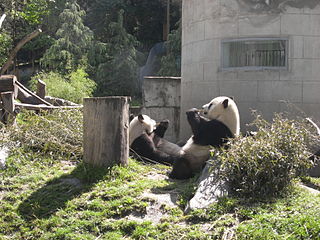
The giant panda, also known as the panda bear or simply the panda, is a bear native to south central China. It is characterised by large, black patches around its eyes, over the ears, and across its round body. The name "giant panda" is sometimes used to distinguish it from the red panda, a neighboring musteloid. Though it belongs to the order Carnivora, the giant panda is a folivore, with bamboo shoots and leaves making up more than 99% of its diet. Giant pandas in the wild will occasionally eat other grasses, wild tubers, or even meat in the form of birds, rodents, or carrion. In captivity, they may receive honey, eggs, fish, yams, shrub leaves, oranges, or bananas along with specially prepared food.

The red panda is a mammal species native to the eastern Himalayas and southwestern China. It is listed as Endangered on the IUCN Red List because the wild population is estimated at fewer than 10,000 mature individuals and continues to decline due to habitat loss and fragmentation, poaching, and inbreeding depression. Despite its name, it is not closely related to the giant panda.

Zoo Atlanta is an Association of Zoos and Aquariums (AZA) accredited zoological park in Atlanta, Georgia. The current President and CEO of Zoo Atlanta is Raymond B. King.

Adelaide Zoo is Australia's second oldest zoo, and it is operated on a non-profit basis. It is located in the parklands just north of the city centre of Adelaide, South Australia. It is administered by the Royal Zoological Society of South Australia Incorporated, which is a full institutional member of the Zoo and Aquarium Association (ZAA) and the World Association of Zoos and Aquariums (WAZA), and which also administers the Monarto Safari Park near Murray Bridge.

Panda diplomacy is a term used to describe China's practice of sending giant pandas to other countries as a symbol of diplomatic goodwill.

Tai Shan is a giant panda born at the National Zoo in Washington D.C. on July 9, 2005 at 3:41 AM. He is the first panda cub born at the National Zoo to survive for more than a few days.

Wolong National Nature Reserve, also known as Wolong Special Administrative Region, is a protected area located in Wenchuan County, Sichuan Province, People's Republic of China. Established in 1963 with an initial size of about 20,000 hectares, the reserve was further expanded in 1975, covering an area of about 200,000 hectares in the Qionglai Mountains region. There are over 4,000 different species recorded in the reserve. According to China's Third National Giant Panda Survey, Wolong National Nature Reserve houses about 150 wild individuals of highly endangered giant pandas. The reserve is also a home to many other endangered species including: snow leopards, red pandas, golden monkeys, white-lipped deer and many precious plants. Before the devastating 2008 Wenchuan earthquake Wolong got up to 200,000 visitors every year. Its area is superseded by the Wolong Special Administrative Region.
Mei Xiang is a female giant panda who lives at the National Zoo in Washington D.C.

Bai Yun is a female giant panda sheltered at the San Diego Zoo. Bai Yun was the first successful birth of a giant panda at the Wolong Giant Panda Research Center in China. She lived at the San Diego Zoo from September 1996 to May 2019, at which time she returned to China. Bai Yun gave birth to her sixth cub in 2012 since arriving at the San Diego Zoo, considered the most surviving pandas born at a breeding facility outside of native China. Bai Yun returned to China with her sixth cub in May, 2019, as the 23-year conservation loan of the pandas came to an end between China and San Diego Zoo Global.

Gao Gao is a male giant panda formerly at the San Diego Zoo. He was returned to China in 2018. To date, he has fathered five giant pandas in captivity.

Chengdu Research Base of Giant Panda Breeding, or simply Chengdu Panda Base, is a non-profit research and breeding facility for giant pandas and other rare animals. It is located in Chengdu, Sichuan, China.

Tuan Tuan and Yuan Yuan are two giant pandas that were sent by mainland China to Taiwan in 2008 as part of an exchange program. The exchange idea was first proposed in 2005, but the previous administration in Taiwan had refused to accept the pandas. After elections that resulted in a change of presidents in 2008, Taipei accepted the pandas, and they arrived in Taiwan on December 23, 2008. The two names were selected by a vote in the PRC and their combination, Tuan Yuan, means "reunion" in Chinese. The pandas are being housed at Taipei Zoo and have been exhibited to the public since the 2009 Chinese New Year.

Bifengxia Giant Panda Base is a giant panda research and breeding facility in Bifengxia Town, Ya'an, Sichuan, China. Since opening in 2004, it has become home to several more giant pandas. This includes the U.S.-born Hua Mei and Mei Sheng, who were relocated there after the May 12, 2008, Sichuan earthquake severely damaged the panda breeding center at the Wolong National Nature Reserve. Both facilities are managed by the China Conservation and Research Center for the Giant Panda.

Chuang Chuang and Lin Hui are two giant pandas from Sichuan, China on loan to Chiang Mai Zoo in Chiang Mai, Thailand.

Jinan Zoo (济南动物园), formerly known as Taurus Park was founded in October 1959. It opened 1 May 1960, and was renamed Jinan Zoo on 8 September 1989. Jinan Zoo is one of China's largest zoos in it is located in Shandong province.
Rebecca Spindler is the Head of Science and Conservation at non profit conservation organisation Bush Heritage Australia. She previously was the Manager of Research and Conservation at Taronga Conservation Society Australia, in the New South Wales Office of Environment and Heritage (OEH).
As of 2019, there are 26 zoos in 20 countries outside of mainland China that have giant pandas. These zoos have contracts with China to house these pandas for a few years. Giant pandas are on the IUCN Red List so part of the reason these contracts exist between China and international zoos is to try to help the species reproduce before they are brought back to their native land. For this reason, pandas are treated very well.

Bei Bei is a male giant panda cub who was born and lived at the National Zoo in Washington, D.C., in the United States. He was part of US-China relations panda diplomacy, and was sent to the People's Republic of China on November 19, 2019 at the age of 4. He is now at the Ya’an Bifengxia Base of the Giant Panda Conservation and Research Center in southwest Sichuan province. He is the brother of both Tai Shan and Bao Bao.

The term Chinese leopard refers to any of the following three leopard subspecies occurring in China:
















